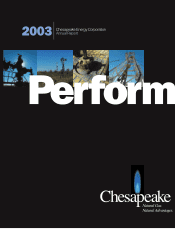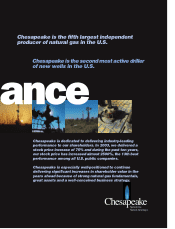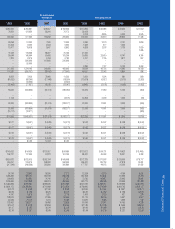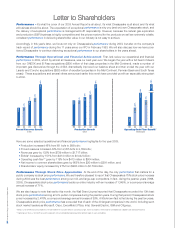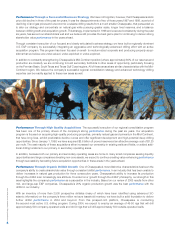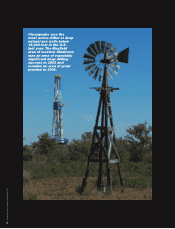Chesapeake Energy 2003 Annual Report Download - page 9
Download and view the complete annual report
Please find page 9 of the 2003 Chesapeake Energy annual report below. You can navigate through the pages in the report by either clicking on the pages listed below, or by using the keyword search tool below to find specific information within the annual report.
These onshore natural gas wells provide a safe and reliable source of the clean energy our country increasingly demands.
Across our entire base of operations, Chesapeake balances risk and return opportunities, with one-third of our drilling
focused on low-risk developmental targets at depths shallower than 10,000 feet, one-third on medium depth drilling con-
sisting of developmental and higher-potential targets between 10-15,000 feet and one-third targeting deeper exploratory
targets with significant upside potential below 15,000 feet. This balanced range of prospects provides the company with one
of the largest and most attractive drilling inventories of all E&P companies and will play an important role in enabling
Chesapeake to continue delivering industry-leading
performance
in the years ahead.
Performance
Through Building Regional Scale One of the keys to consistently delivering great
performance
in the
E&P industry is building scale in a limited number of core operating areas. Achieving economies of scale provides many
important benefits, including higher per unit revenues, lower per unit costs, greater drilling success, better acquisition results,
and higher returns on invested capital. Chesapeake first began pursuing regional scale in the Mid-Continent in 1998 and
the success of our strategy has enabled the company to become the region’s largest natural gas producer, its most active
driller and its most active acquirer of producing and non-producing properties.
We favor the Mid-Continent because it offers many attractive characteristics. These characteristics include long-lived natu-
ral gas properties with predictable decline curves, multiple-pay geological targets, strong oil and natural gas prices, lower
service costs, and a favorable regulatory environment with virtually no federal land ownership. Chesapeake’s secondary
operating areas possess many of these same characteristics. The company’s regional scale and focus should provide
significant
performance
opportunities for Chesapeake’s shareholders in the years ahead.
Performance
Through Maintaining a Low Cost Structure By minimizing the operating cost of the company’s
wells and reducing general and administrative expenses through strict cost controls and regional operating scale, we have
been able to deliver attractive financial
performance
through almost all phases of the commodity price cycle. Chesapeake’s
low cost structure is the result of management’s effective cost-control programs, a high-quality asset base and the extensive
and competitive service, processing and transportation infrastructures that exist in our core operating areas. By maintaining
a low cost structure, we are able to achieve high returns on Chesapeake’s capital and deliver strong operational and finan-
cial
performance
to our shareholders, including a gross profit margin of 39% and a return on equity of 32% in 2003.
Performance
Through Successful Risk Management During the past six years, Chesapeake has developed
a distinctive identity in the industry by being one of the earliest to predict that the U.S. would begin experiencing the
increasingly volatile natural gas prices that are with us today. For years, our view that U.S. natural gas production would peak
and then start an inexorable decline (just as oil production has been declining in the U.S. for more than 30 years) was not
widely shared. Our view that natural gas prices would increase significantly as a result was also not widely shared and, in
fact, was just the opposite of what our federal government had been forecasting.
The company’s anticipation of accelerating U.S. production declines and the resulting natural gas price volatility led to the
development of our commodity price risk management policies that have generated industry-leading hedging results. In fact,
during the past three years alone, we have generated realized hedging gains of over $180 million. By investing this extra
revenue in the company’s drilling program, we have been able to create over $300 million of additional reserve value through
risk management. Although we do not expect to generate increased revenues from our hedging program every year, over
time we believe this program can generate significant value while substantially reducing commodity price risk for
our shareholders.
Performance
Through Improving Our Balance Sheet A key driver of Chesapeake’s exceptional stock price
performance
in 2003 and during the past six years has been the significant improvement made to our balance sheet. When
our stock price declined in 1997 and 1998 because of the operational setbacks and declining oil and gas prices mentioned
earlier, the company was forced to significantly write down the value of its assets. This reduction in asset value caused our
debt to total capitalization to reach a peak of 137% at year-end 1998.
However, through strong earnings growth and several equity offerings built around some of our larger acquisitions, we have
reduced Chesapeake’s debt to total capitalization to below 50%. We have also reduced the average interest rate of our out-
standing senior notes to 7.7% and have extended our average senior note maturity to 9.6 years. After paying
off $46 million of senior notes in March 2004, we now have only $210 million of senior note maturities in the next
seven years.
The benefits to our shareholders from these steady improvements in Chesapeake’s balance sheet include a lower cost of
capital, increased shareholder confidence in the company’s ability to create value even when commodity prices are unfa-
vorable and a higher trading multiple for our common stock. One of our key financial goals continues to be reducing the
Chesapeake Energy Corporation Annual Report 2003
5

